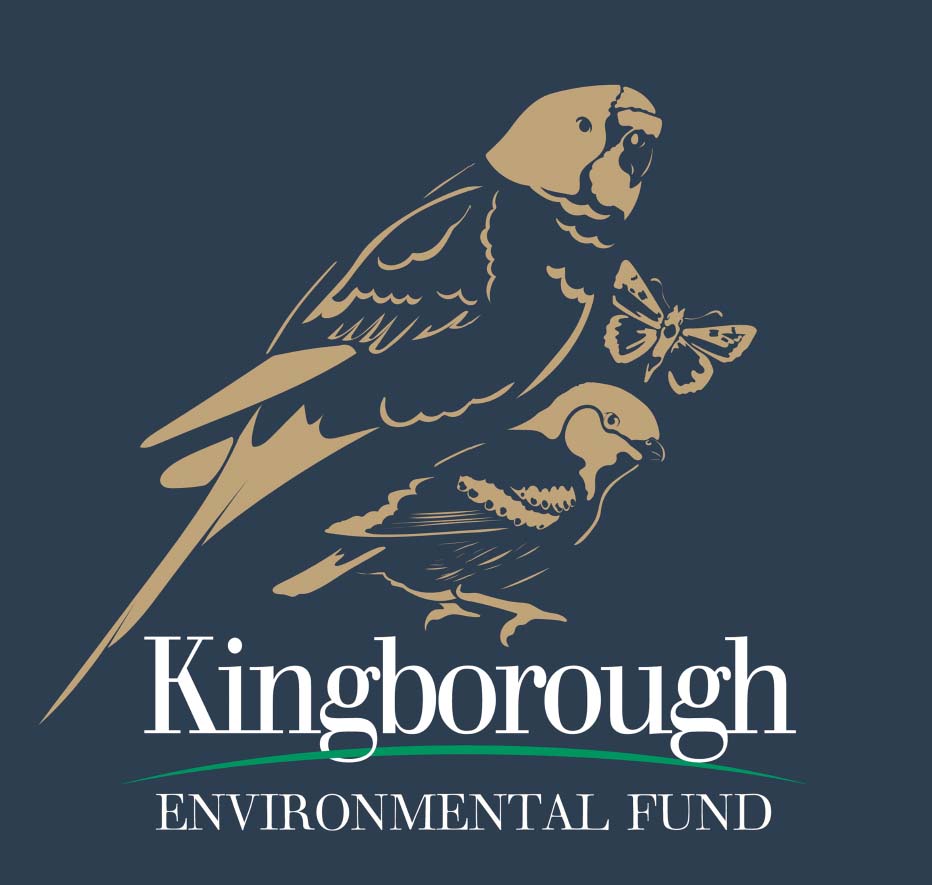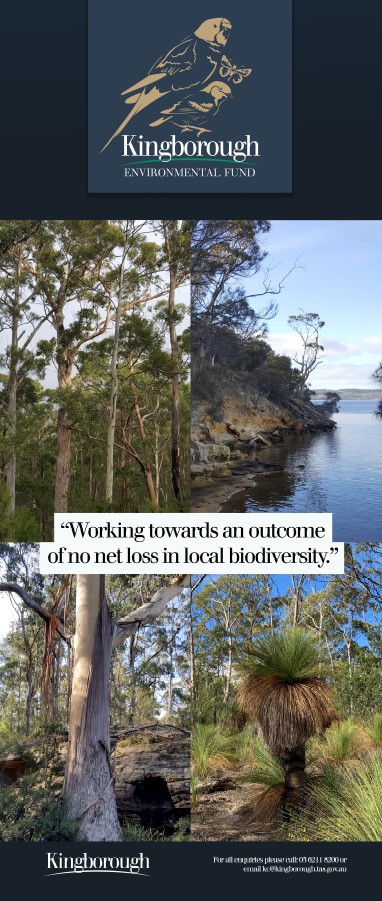Kingborough is recognised as containing a high proportion of significant biodiversity values including being the only municipality in Tasmania where endangered forty-spotted pardalotes are found on private land and being home to core foraging and breeding habitats for the critically endangered Swift Parrot. These species were once widespread, but are now facing extinction due to habitat loss, predators and other environmental changes.
That’s why we’re taking action to make sure loss of critical habitat is minimised and any residual impacts that can’t be avoided are offset using Council’s Biodiversity Offset Policy.
Council began utilising biodiversity offsets in 2004 as an innovative approach to tackling the challenge of balancing development whilst conserving biodiversity for the future. The greatest demand for offsets is from areas on the urban fringe and is generally associated with residential development, including new subdivisions, home and roads.

THE ENVIRONMENT FUND
The Kingborough Environmental Fund collects financial offsets paid by developers and landowners for the loss of high conservation value vegetation in Kingborough.
Most offsets are received for the loss of threatened species habitat such as swift parrot, forty spotted pardalote, or for the loss of threatened vegetation communities in Kingborough.
The funds are then reinvested into the community through local environmental projects which secure the offset that was required by the planning authority. Pooling contributions in the fund allows a strategic approach to securing offsets, leading to targeted protection and improvement of biodiversity.
To ensure Council administers the fund with scientific rigour and good governance it is overseen by a Steering Committee made up of ecologists, landowners and a State Government representative. The Guidelines for Expenditure of the Kingborough Environmental Fund provide the rules which ensure the financial contributions within the fund are spent appropriately on offset projects. The details of each contribution within the fund are recorded to ensure the loss of biodiversity values can be tracked and the conditions of the offset reconciled.
The Fund invests in three delivery streams;
- New conservation reserves on private land
- New habitat planting projects
- Recovery actions for threatened species
The creation of new conservation reserves on private land is the most important delivery stream for the fund. Investing in private land conservation allows the fund to offset the loss of biodiversity values that don’t necessarily occur within national parks and reserves and allows landowners to do something very positive for the greater good.
The Kingborough Environmental Fund Implementation Plan below oversees and guides the expenditure of the fund over a period of four years.
Kingborough Environmental Fund Implementation Plan
If you have paid a biodiversity offset and would like to see what project is has been directed towards, please click on the following link. For any further information on past and future expenditure please contact Council’s Natural Areas and Biodiversity Team on 6211 8200.
KEF Contribution & Retribution Table – click to download .pdf
KEF SNAPSHOT

As of January 2024 Financial offsets received: $1,277,491.36
Financial offsets expended: $554,503.41
Financial offsets expenditure still to be achieved: $722,987.95
- How much land (ha) has been protected as a result of the fund
Total of 242.9 ha protected over 6 covenants including:
- Black peppermint forest on sandstone – 65.8 ha
(exceeded target by 39.19 ha) - Blue gum dry forest and woodland – 105.3 ha
(exceeded target by 101.58 ha) - Silver peppermint forest on sediments – 10.5 ha
(exceeded target by 5.75 ha) - Of this its estimated that we have protected:
- Over 125 ha swift parrot habitat
(exceeded target by at least 104.77 ha) - Over 33 ha forty-spotted pardalote habitat
(exceeded target by at least 27.89 ha) - Over 3 ha chaostola skipper habitat
(exceeded target by at least 2.21 ha) - Over 5 ha Epacris virgata habitat
(exceeded target by at least 4.57 ha)
Kingborough Environmental Fund FAQ’s
What is the Kingborough Environmental Fund (KEF)?
The KEF collects financial offsets paid by developers and landowners for the loss of high conservation value vegetation in Kingborough.
What are offsets?
Offsets are the last step in a process where impacts on biodiversity are in the first instance avoided, then minimised, and any unavoidable impacts then offset. Offsetting aims to avoid an overall loss in the extent and quality of biodiversity values.
What is the difference between the KEF and the Council’s Biodiversity Offset Policy?
The Biodiversity Offset Policy is the tool Council uses to capture the loss of biodiversity values associated with applications assessed under a planning scheme or by-law regulating vegetation removal. The KEF is how Council delivers projects associated with the financial offsets received through the Biodiversity Offset Policy.
What are the different types of offsets?
During an application process where offsets are required, values are first attempted to be offset through ‘on-site offsets’ where adjacent land containing the same values is protected in perpetuity. If this is not achievable then the protection of similar values on another property using an ‘off-site offset’ is sought. The final option if the first two options are unsuitable is a ‘financial offset’, which is received by Council into the KEF.
How much money has been received in financial offsets by the KEF?
The KEF has received over $1,200,000 since 2004. As of 2024, approximately 50% of this had been spent through the implementation of offset projects.
Who decides what the financial offsets are spent on?
The permit condition associated with a financial offset outlines the way in which it is to be spent. Different financial offsets for the same values can be grouped together, helping achieve a great impact. The KEF Steering Committee, made up of technical experts and industry representatives also helps ensure that offsets are spent in a transparent and appropriate manner.
What biodiversity values are most often offset by Council?
Most offsets received by Council have been for threatened species habitat (e.g. swift parrot, forty-spotted pardalote, chaostola skipper), or threatened vegetation communities (e.g. Eucalyptus ovata forest and woodland, Eucalypts amygdalina forest and woodland on sandstone, Eucalyptus tenuiramis forest and woodland on sediments, Eucalyptus globulus dry forest and woodland).
What role do Councillors have in the KEF?
Councillors receive regular updates on how the implementation of projects under the KEF is proceeding, but do not have a decision-making role in the process.
Does Council spend the money operationally on Council land?
Financial offsets are not spent as part of Councils operational processes. A number of revegetation projects have been established on Council land in line with the ‘Guidelines for the Expenditure of the Kingborough Environmental Fund’, but these were not considered to be operational in nature.
Who undertakes the work for offsets received by the KEF?
Projects under the KEF are implemented by a Project Manager who has been employed by Council since 2018. On-ground works such as revegetation, weed control and fencing are undertaken by external contractors in line with Council’s Purchasing Policy.
What is a conservation covenant?
A conservation covenant is used to create a nature reserve on private land to conserve an area of significant biodiversity. A covenant is a legally binding agreement under the Tasmanian Nature Conservation Act (2002) and registered on land title. Covenants are part of the National Reserve System and the primary mechanism to secure conservation values on private land in perpetuity.
What are the benefits of conservation covenants for landowners?
Landowners that agree to establishing a conservation covenant on their land are able to seek a Council rate rebate, and land tax exemptions. Under the KEF, landowners also have the benefit of stewardship, where the KEF covers the cost on management actions including revegetation, weed control and fencing.
Is the KEF achieving its targets?
Yes, as of 2024 the KEF has met 78% of its overall targets for private land conservation. With one more revegetation project planned for the coming years the KEF has currently met 76% of its revegetation target. It is likely that Council will continue to receive financial offsets, and as such, the current targets may increase.
